Click on images to enlarge
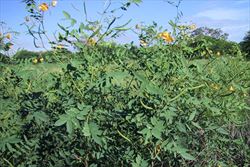
habit (Photo: Chris Gardiner)
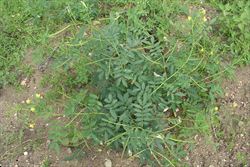
habit (Photo: Chris Gardiner)

once-compound leaves with pointed tips (Photo: Chris Gardiner)

close-up of stem and raised glands on the leaf stalks (Photo: Sheldon Navie)

close-up of leaflets (Photo: Sheldon Navie)
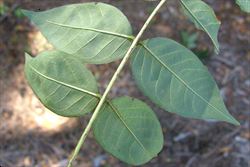
close-up of leaflet undersides (Photo: Sheldon Navie)
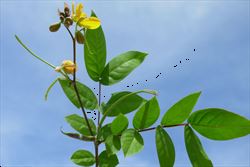
flowers and young fruit (Photo: Chris Gardiner)

close-up of flower (Photo: Forest and Kim Starr, USGS)
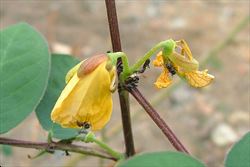
close-up of stems and old flowers (Photo: Sheldon Navie)

close-up of immature fruit (Photo: Sheldon Navie)
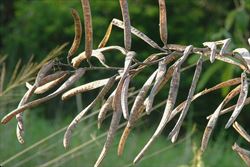
mature fruit (Photo: Sheldon Navie)

close-up of elongated mature fruit (Photo: Sheldon Navie)
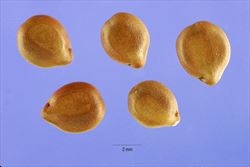
close-up of seeds (Photo: Steve Hurst at USDA PLANTS Database)

young plant (Photo: Sheldon Navie)
Scientific Name
Senna occidentalis (L.) Link
Synonyms
Cassia occidentalis L.
Family
Caesalpiniaceae (Queensland, the ACT, Victoria, Tasmania, Western Australia and the Northern Territory) Fabaceae: sub-family Caesalpinioideae (New South Wales)Leguminosae (South Australia)
Common Names
ant bush, antbush, arsenic bush, coffee senna, negro coffee, Nigerian senna, septicweed, sickle pod, stink weed, stinking pea, stinking weed, stinkingweed, stinkweed, styptic weed
Origin
Native to the tropical and sub-tropical regions of the Americas.
Naturalised Distribution
Widely naturalised in the coastal and sub-coastal regions of northern Australia. It is most common in the coastal districts of Queensland and the Northern Territory. It has a scattered distribution in the northern parts of Western Australia and in the inland regions of Queensland and the Northern Territory. Also recorded in some inland parts of northern and western New South Wales, in north-eastern South Australia and on some offshore islands (i.e. Christmas Island and the Cocos Islands).
Also naturalised in southern and eastern USA.
Habitat
A weed of roadsides, waste areas, disturbed sites, pastures, grasslands, open woodlands, coastal environs and crops in tropical, sub-tropical and semi-arid regions.
Habit
An upright (i.e. erect) and short-lived (i.e. annual or biennial) shrub growing 0.5-2.5 m tall.
Distinguishing Features
- a short-lived slender shrub growing up to 2.5 m tall.
- its once-compound leaves consist of three to five pairs of leaflets (3-10 cm long and 2-3 cm wide) that have pointed tips.
- there is a conspicuous dark-coloured gland near the base of the stalk of each leaf.
- its flowers (2-3 cm across) have five yellow petals and are borne in small clusters in the upper leaf forks.
- its fruit is a somewhat flattened, straight or slightly sickle-shaped, pod (7.5-13 cm long and 8-10 mm wide).
- this species gives off a foul odour when damaged.
Stems and Leaves
The upright (i.e. erect) stems are sparsely branched, smooth and hairless (i.e. glabrous) or sparsely hairy (i.e. puberulent). They are reddish-purple in colour and somewhat four-angled (i.e. quadrangular) or grooved when young, but turn greenish-brown in colour and become rounded as they mature.
The alternately arranged, compound (i.e. pinnate) leaves (15-20 cm long) are borne on reddish stalks (i.e. petioles) 3-5 cm long. They have three to five pairs of oppositely arranged leaflets (3-10 cm long and 2-3 cm wide) that are egg-shaped in outline (i.e. ovate) or oval (i.e. elliptic) in shape. These leaflets have entire margins and pointed tips (i.e. acuminate apices). There is a conspicuous dark-coloured gland near the base of each leaf stalk (i.e. petiole).
Flowers and Fruit
The bright yellow flowers (20-30 mm across) have five petals (10-15 mm long) and are borne in small clusters (of 2-6 flowers) in the forks (i.e. axils) of the uppermost leaves. These flowers have six stamens and four tiny petal-like structures (i.e. staminodes) at their centres. Flowering occurs mostly during summer and autumn.
The fruit is a flattened (i.e. compressed) and slightly sickle-shaped (i.e. falcate) or almost straight pod (75-130 mm long and 8-10 mm wide). These pods are held upright or curve slightly upwards. They turn dark brown as they mature, but have paler stripes along their edges (i.e. sutures), and each contains 20-35 seeds. The seeds are dark brown in colour, flattened (i.e. compressed) and about 5 mm long by 3 mm wide.
Reproduction and Dispersal
This plant reproduces entirely by seed.
Seeds are dispersed by water or in mud sticking to animals, humans, machinery and vehicles. They may also be spread as a contaminant of agricultural produce.
Environmental Impact
Coffee senna (Senna occidentalis) is regarded as an environmental weed in Queensland, the Northern Territory and Western Australia. It is actively managed by community groups in the Northern Territory.
Other Impacts
Legislation
This species is declared under legislation in the following states and territories:
- Northern Territory: B - spread to be controlled (throughout all of the Territory), and C - not to be introduced into the Territory.
- Western Australia: Prohibited - on the prohibited species list and not permitted entry into the state.
Management
For information on the management of this species see the following resources:
- the Northern Territory Department of Natural Resources, Environment and The Arts Agnote on this species, which is available online at http://www.nt.gov.au/weeds.
Similar Species
Coffee senna (Senna occidentalis) is very similar to sicklepod (Senna obtusifolia), Java bean (Senna tora), hairy senna (Senna hirsuta), smooth senna (Senna septemtrionalis) and the native arsenic bush (Senna planitiicola). It is also relatively similar to Easter cassia (Senna pendula var. glabrata) and pepper-leaved senna (Senna barclayana). These species can be distinguished by the following differences:
- coffee senna (Senna occidentalis) is a relatively small slender shrub (usually 0.5-2 m tall) that has leaves with several (3-7) pairs of leaflets. The relatively large leaflets (30-100 mm long) are relatively broad (20-40 mm wide) and have pointed tips (i.e. acute apices). Its flowers are borne in small clusters in the leaf forks and its very elongated (7.5-13 cm long) pods are rounded (i.e. cylindrical) or slightly flattened and relatively thick (6-11 mm wide). These pods are straight or slightly-curved upwards and are mostly hairless (i.e. glabrous).
- hairy senna (Senna hirsuta) is a relatively small slender shrub (usually 0.5-2 m tall) that has leaves with several (2-6) pairs of leaflets. These relatively large leaflets (40-105 mm long) are relatively broad (20-40 mm wide) and have pointed tips (i.e. acute apices). Its flowers are borne in small clusters in the leaf forks and its very elongated (10-18 cm long) pods are usually somewhat flattened and very narrow (4-6 mm wide). These pods are slightly-curved downwards and are densely covered in long white hairs (i.e. pubescent).
- sicklepod (Senna obtusifolia) is a relatively small slender shrub (usually 0.5-2 m tall) that has leaves with a few (2-3) pairs of leaflets. The relatively large leaflets (17-65 mm long) are relatively broad (15-40 mm wide) and have rounded tips (i.e. obtuse apices). Its flowers are borne in pairs in the leaf forks and the very elongated (6-18 cm long) pods are almost rounded in cross-section (i.e. cylindrical) and very narrow (2-6 mm wide). These pods are strongly curved downwards (i.e. sickle-shaped) and are mostly hairless (i.e. glabrous).
- Java bean (Senna tora) is a relatively small slender shrub (usually 0.5-2 m tall) that has leaves with a few (2-4) pairs of leaflets. The moderately-sized leaflets (10-40 mm long) are relatively broad (10-35 mm wide) and have rounded tips (i.e. obtuse apices). Its flowers are borne in pairs in the leaf forks and its very elongated (12-25 cm long) pods are almost rounded in cross-section (i.e. cylindrical) and very narrow (2-6 mm wide). These pods are strongly curved downwards (i.e. sickle-shaped) and are mostly hairless (i.e. glabrous). This species also gives off a strong unpleasant smell.
- smooth senna (Senna septemtrionalis) is a moderately-sized shrub (1-3 m tall) that has leaves with several (3-5) pairs of leaflets. The relatively large leaflets (45-70 mm long) are relatively broad (15-35 mm wide) and have pointed tips (i.e. acute apices). Its flowers are borne in relatively loose and somewhat elongated clusters (i.e. racemes) and its elongated (6-10.5 cm long) pods are almost rounded in cross-section (i.e. cylindrical) and relatively thick (10-15 mm wide). These pods are straight and mostly hairless (i.e. glabrous).
- arsenic bush (Senna planitiicola) is a relatively small slender shrub (usually 0.5-2 m tall) that has leaves with several (5-7) pairs of leaflets. The moderately-sized leaflets (25-50 mm long) are relatively broad (15-25 mm across) and have somewhat pointed tips (i.e. acute apices). Its flowers are borne in small clusters in the leaf forks and its relatively short (less than 8.5 cm long) pods are almost rounded in cross-section (i.e. cylindrical) and relatively thick (8-11 mm wide). These pods are straight and mostly hairless (i.e. glabrous).
- Easter cassia (Senna pendula var. glabrata) is a moderately-sized shrub (2-4 m tall) that has leaves with several (3-6) pairs of leaflets. The moderately-sized leaflets (20-50 mm long) are relatively broad (10-20 mm wide) with rounded tips (i.e. obtuse apices) and prominent yellowish coloured margins. Its flowers are borne in relatively loose leafy clusters and its elongated (10-20 cm long) pods are almost rounded in cross-section (i.e. cylindrical) and relatively thick (8-12 mm wide). These pods are relatively straight, sometimes have one or more constrictions, and are hairless (i.e. glabrous).
- pepper-leaved senna (Senna barclayana) is a low-growing shrub (usually less than 1 m tall) that has leaves with several (4-10) pairs of leaflets. The moderately-sized leaflets (20-50 mm long) are relatively narrow (4-15 mm wide) and have pointed tips (i.e. acute apices). Its flowers are borne in small clusters in the leaf forks and its relatively short (3-7 cm long) pods are almost rounded in cross-section (i.e. cylindrical) and relatively thick (6-9 mm wide). These pods are straight and hairless (i.e. glabrous).

